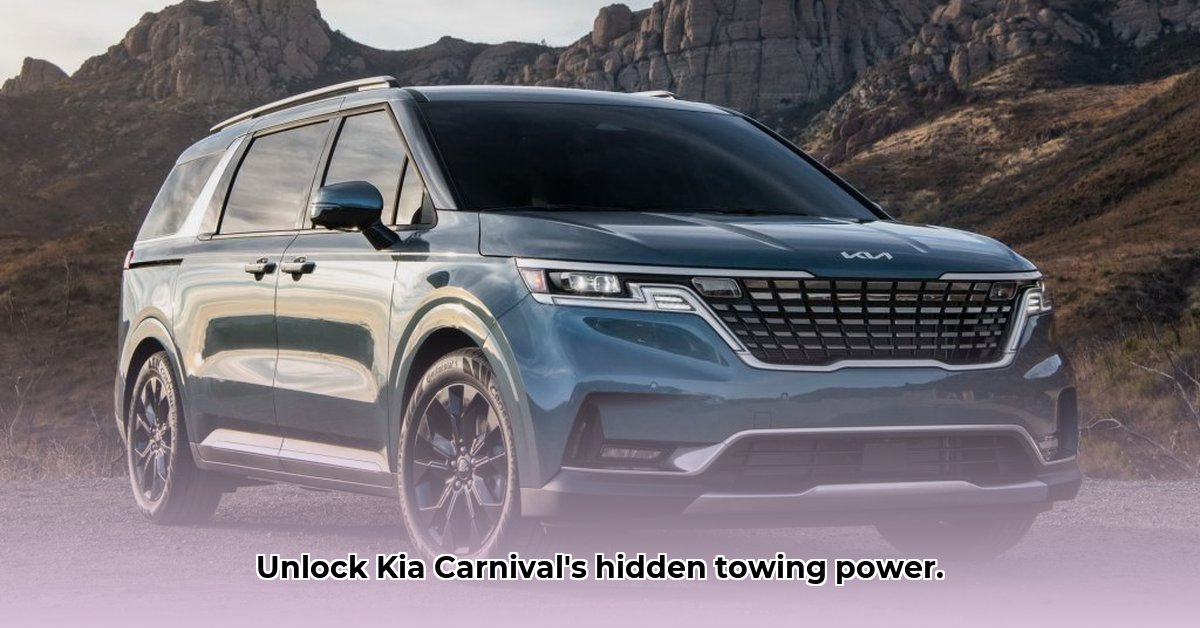
Thinking about towing with your Kia Carnival? This comprehensive guide provides everything you need to know for a safe and legal towing experience. We'll cover towing capacities, essential equipment, installation instructions, safety precautions, and troubleshooting tips. For comparison, see the Ford Ranger towing capacity information.
Understanding Your Kia Carnival's Towing Capacity
Your Kia Carnival's towing capacity depends on whether your trailer has brakes and your specific model year and engine type. Exceeding the manufacturer's recommended weight is unsafe and illegal. Always check your owner's manual for the most accurate information specific to your vehicle. Isn't it crucial to understand these limitations before you even consider towing?
Braked vs. Unbraked Towing Capacity
The difference between braked and unbraked towing capacity is significant. A trailer with brakes allows you to tow significantly more weight. Why? Because the trailer's brakes assist your vehicle’s braking system.
Here's a summary of towing capacities for select Kia Carnival models (always verify with your owner's manual):
| Kia Carnival Model | Braked Towing Capacity (lbs) | Unbraked Towing Capacity (lbs) |
|---|---|---|
| Gasoline (2022-2023) | 3,500 | 1,500 |
| Hybrid (2025) | 2,500 | 1,000 |
Essential Equipment for Safe Towing
Safe towing requires more than just hooking up your trailer. You need specific equipment to ensure stability and visibility. Did you know that improper equipment can lead to serious accidents?
- Class III Hitch: A Class III hitch (a heavy-duty hitch designed for towing) is essential. Expect to pay between $100 and $300, plus installation costs. Source from authorized Kia dealers or reputable online retailers.
- Wiring Harness: This connects your vehicle's electrical system to your trailer's lights. It's crucial for visibility and safety. Purchase a harness specifically designed for your Kia Carnival's year and model.
- Trailer Brakes (if required): If your trailer's weight exceeds the unbraked towing capacity specified for your vehicle, trailer brakes are absolutely mandatory. Professional installation is recommended.
Installation Guide: Hitch and Wiring Harness
While some individuals might attempt DIY installation, professional installation is strongly encouraged, especially for the hitch. The safety of yourself and others is paramount. The cost of professional installation for a hitch and wiring harness typically ranges from $200 to $400 depending on your area.
Installing a Class III Hitch (Professional Installation Recommended)
Professional installation ensures the hitch is properly secured to your vehicle's frame, preventing dangerous detachment during towing. A professional mechanic can ensure the install meets safety standards.
Installing a Wiring Harness (Factory-Style)
For a factory-style harness:
- Gather Your Tools: Consult the wiring harness's instructions for specific tools.
- Locate Connection Points: Identify the connection points on your vehicle's wiring harness. Your harness instructions will outline this specifically.
- Connect the Harness: Carefully connect the plugs, ensuring secure engagement.
- Test the Lights: Test all trailer lights to confirm they're working correctly.
- Secure the Harness: Secure loose wiring to prevent damage or interference.
Safety Precautions for Towing
Safe towing practices are crucial for preventing accidents. It's not just about having the right equipment; it's about using it correctly. Has anyone ever told you that the most common towing mistake is improper weight distribution?
- Proper Weight Distribution: Distribute weight evenly across the trailer to prevent swaying.
- Secure Connections: Verify all connections before each trip. A loose connection is hazardous.
- Brake Control (if applicable): Properly adjust the brake controller for optimal performance.
- Obey Traffic Laws: Obey all speed limits and traffic laws, taking into consideration the reduced maneuverability while towing.
Troubleshooting Common Towing Problems
Even with proper preparation, issues can arise. Here are some common problems and solutions:
- Trailer Lights Not Working: Check bulbs, connections, and fuses. Consult your vehicle's manual for fuse box locations.
- Trailer Sway: Reduce speed immediately and adjust weight distribution. Consider using sway control devices.
- Overheating: This indicates overloading. Ensure proper maintenance and never exceed towing capacity.
Conclusion
Understanding your Kia Carnival's towing capabilities and practicing safe towing procedures is crucial. Always prioritize safety and consult your owner's manual or a qualified professional when needed. Remember, safe towing means a smoother, safer journey for everyone.